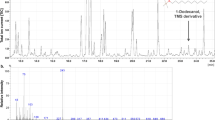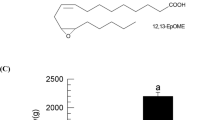Abstract
The bacteria Xenorhabdus spp. are entomopathogenic symbionts that can produce several toxic proteins that interfere the immune system of insects. We purified an insecticidal protein from Xenorhabdus ehlersii, and designated it as XeGroEL with an estimated molecular mass of ~58 kDa. Galleria mellonella larva injected with XeGroEL presented prophenoloxidase activation and hemocyte decrease. XeGroEL can kill G. mellonella larva in 48 h with an LD50 of 0.76 ± 0.08 μg/larva. Our results demonstrate that X. ehlersii possesses a toxic XeGroEL protein acting as a potential factor to activate proPO in host insect, which also provides a meaningful hypothesis to understand the interaction between nematode-symbiotic bacteria and host.




Similar content being viewed by others
References
Altincicek B, Linder M, Linder D, Preissner KT, Vilcinskas A (2007) Microbial metalloproteinases mediate sensing of invading pathogens and activate innate immune responses in the Lepidopteran model host Galleria mellonella. Infect Immun 75:175–183
Bode HB (2009) Entomopathogenic bacteria as a source of secondary metabolites. Curr Opin Chem Biol 13:224–230
Bouvaine S, Boonham N, Douglas AE (2011) Interactions between a luteovirus and the GroEL chaperonin protein of the symbiotic bacterium Buchnera aphidicola of aphids. J Gen Virol 92:1467–1474
Braig K, Otwinowski Z, Hegde R, Boisvert DC, Joachimiak A, Horwich AL, Sigler PB (1994) The crystal structure of the bacterial chaperonin GroEL at 2.8 Å. Nature 371:578–586
Brown SE, Cao AT, Hines ER, Akhurst RJ, East PD (2004) A novel secreted protein toxin from the insect pathogenic bacterium Xenorhabdus nematophila. J Biol Chem 279:14595
Cabral CM, Cherqui A, Pereira A, Simoes N (2004) Purification and characterization of two distinct metalloproteases secreted by the entomopathogenic bacterium Photorhabdus sp. strain Az29. Appl Environ Microbiol 70:3831–3838
Calderwood SK, Mambula SS, Gray PJ (2007) Extracellular heat shock proteins in cell signaling and immunity. Ann NY Acad Sci 1113:28–39
Cerenius L, Lee BL, Soderhall K (2008) The proPO-system: pros and cons for its role in invertebrate immunity. Trends Immunol 29:263–271
Choo YM, Lee KS, Yoon HJ, Kim BY, Sohn MR, Roh JY, Je YH, Kim NJ, Kim I, Woo SD, Sohn HD, Jin BR (2010) Dual function of a bee venom serine protease: prophenoloxidase-activating factor in arthropods and fibrin(ogen)olytic enzyme in mammals. PLoS One 5:e10393
Cowles KN, Goodrich-Blair H (2005) Expression and activity of a Xenorhabdus nematophila haemolysin required for full virulence towards Manduca sexta insects. Cell Microbiol 7:209–219
Fenton WA, Kashi Y, Furtak K, Norwich AL (1994) Residues in chaperonin GroEL required for polypeptide binding and release. Nature 371:614–619
Forst S, Dowds B, Boemare N, Stackebrandt E (1997) Xenorhabdus and Photorhabdus spp.: bugs that kill bugs. Annu Rev Microbiol 51:47–72
Guo L, Fatig RO, Orr GL, Schafer BW, Strickland JA, Sukhapinda K, Woodsworth AT, Petell JK (1999) Photorhabdus luminescens W-14 insecticidal activity consists of at least two similar but distinct proteins. J Biol Chem 274:9836–9842
Hancock REW, Brown KL, Mookherjee N (2006) Host defence peptides from invertebrates—emerging antimicrobial strategies. Immunobiology 211:315–322
Jiang H (2008) The biochemical basis of antimicrobial responses in Manduca sexta. Insect Sci 15:53–66
Joshi MC, Sharma A, Kant S, Birah A, Gupta GP, Khan SR, Bhatnagar R, Banerjee N (2008) An insecticidal GroEL protein with chitin binding activity from Xenorhabdus nematophila. J Biol Chem 283:28287–28296
Kanost MR, Jiang H, Yu XQ (2004) Innate immune responses of a lepidopteran insect, Manduca sexta. Immunol Rev 198:97–105
Khandelwal P, Banerjee-Bhatnagar N (2003) Insecticidal activity associated with the outer membrane vesicles of Xenorhabdus nematophilus. Appl Environ Microbiol 69:2032–2037
Khandelwal P, Choudhury D, Birah A, Reddy MK, Gupta GP, Banerjee N (2004) Insecticidal pilin subunit from the insect pathogen Xenorhabdus nematophila. J Bacteriol 186:6465–6476
Lavine M, Strand M (2002) Insect hemocytes and their role in immunity. Insect Biochem Mol Biol 32:1295–1309
Morgan JAW, Sergeant M, Ellis D, Ousley M, Jarrett P (2001) Sequence analysis of insecticidal genes from Xenorhabdus nematophilus PMFI296. Appl Environ Microbiol 67:2062
Park SY, Kim CH, Jeong WH, Lee JH, Seo SJ, Han YS, Lee IH (2005) Effects of two hemolymph proteins on humoral defense reactions in the wax moth, Galleria mellonella. Dev Comp Immunol 29:43–51
Park Y, Kim Y, Putnam SM, Stanley DW (2003) The bacterium Xenorhabdus nematophilus depresses nodulation reactions to infection by inhibiting eicosanoid biosynthesis in tobacco hornworms, Manduca sexta. Arch Insect Biochem Physiol 52:71–80
Qi J, He P, Chen W, Wang H, Wang X, Zhang M (2010) Comparative proteome study of apoptosis induced by As4S4 in retinoid acid resistant human acute promyelocytic leukemia NB4-R1 cells. Leuk Res 34:1506–1516
Ranford J, Henderson B (2002) Chaperonins in disease: mechanisms, models, and treatments. Mol Pathol 55:209
Ribeiro C, Vignes M, Brehélin M (2003) Xenorhabdus nematophila (enterobacteriacea) secretes a cation-selective calcium-independent porin which causes vacuolation of the rough endoplasmic reticulum and cell lysis. J Biol Chem 278:3030–3039
Satoh D, Horii A, Ochiai M, Ashida M (1999) Prophenoloxidase-activating enzyme of the silkworm, Bombyx mori. J Biol Chem 274:7441–7453
Shrestha S, Kim Y (2007) An entomopathogenic bacterium, Xenorhabdus nematophila, inhibits hemocyte phagocytosis of Spodoptera exigua by inhibiting phospholipase A2. J Invertebr Pathol 96:64–70
Strand MR (2008) The insect cellular immune response. Insect Sci 15:1–14
Tsakas S, Marmaras V (2010) Insect immunity and its signalling: an overview. Invertebr Surv J 7:228–238
Vigneux F, Zumbihl R, Jubelin G, Ribeiro C, Poncet J, Baghdiguian S, Givaudan A, Brehélin M (2007) The xaxAB genes encoding a new apoptotic toxin from the insect pathogen Xenorhabdus nematophila are present in plant and human pathogens. J Biol Chem 282:9571
Weber F, Keppel F, Georgopoulos C, Hayer-Hartl MK, Hartl FU (1998) The oligomeric structure of GroEL/GroES is required for biologically significant chaperonin function in protein folding. Nat Struct Mol Biol 5:977–985
Yoshida N, Oeda K, Watanabe E, Mikami T, Fukita Y, Nishimura K, Komai K, Matsuda K (2001) Protein function: chaperonin turned insect toxin. Nature 411:44
Acknowledgments
This study was supported by the National Natural Science Foundation of China (31071741) and the International Corporation Project of the Ministry of Agriculture, China (2011-G4).
Author information
Authors and Affiliations
Corresponding authors
Electronic supplementary material
Below is the link to the electronic supplementary material.
Rights and permissions
About this article
Cite this article
Shi, H., Zeng, H., Yang, X. et al. An Insecticidal Protein from Xenorhabdus ehlersii Triggers Prophenoloxidase Activation and Hemocyte Decrease in Galleria mellonella . Curr Microbiol 64, 604–610 (2012). https://doi.org/10.1007/s00284-012-0114-7
Received:
Accepted:
Published:
Issue Date:
DOI: https://doi.org/10.1007/s00284-012-0114-7




